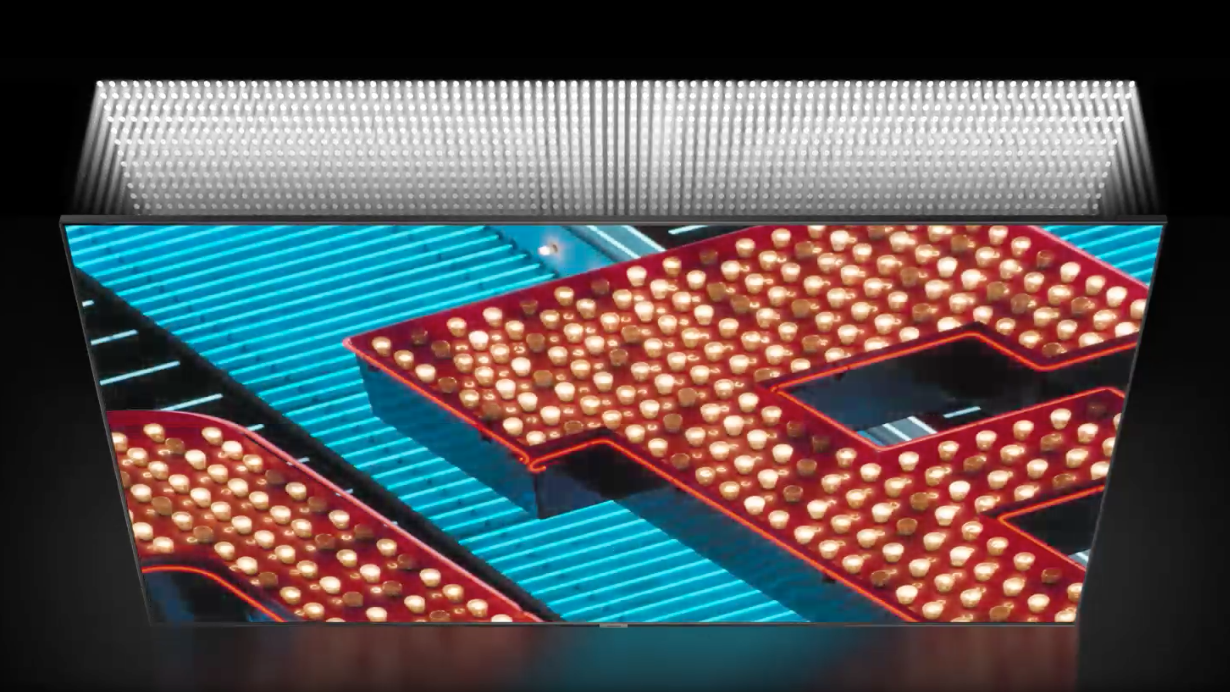
Later this year, when you're looking at the best Samsung TVs, you'll see two key options: QD-OLED and Neo QLED. These are the most advanced screen technologies being used in Samsung's mainstream sets, and they're both based around Quantum Dot technology… but they're very different.
The subject of fevered speculation for a number of years now, QD-OLED finally broke cover at CES 2022, when Samsung Display made the technology official. It offers a number of advantages over the technology used in the best OLED TVs available today.
Neo QLED was introduced in 2021, and it uses mini-LED lights to create dazzlingly bright images, with fine control over contrast.
So exactly what is QD-OLED, how does it differ from Neo QLED, and when will you be able to buy it? This is what we know so far.
Samsung QD-OLED vs Neo QLED: technology explained
Introduced in 2021, Neo-QLED marries Samsung’s long established Quantum Dot enhanced LED TV technology, which is basically an LCD panel coupled to a quantum dot film, with a mini-LED backlight.
Mini-LED allowed Samsung to dispense with traditional LED lens paraphernalia and light guides, used to backlight LCD panels, in favour of thousands of tiny LED lights. The benefits of mini-LED proved to be many and profound.
For one thing, it allowed Samsung to produce much slimmer tellies, making them look a good deal more fashionable than the Full Array Local Dimming (FALD) models which previously were Samsung range toppers. It also offered far greater dimming control and HDR picture handling.
Get all the latest news, reviews, deals and buying guides on gorgeous tech, home and active products from the T3 experts
Neo QLED screens still use Quantum Dot colour technology, obviously, but with the help of proprietary Samsung active control micro layer guides and an all new Quantum processor, these new screens delivered much better black level performance than their predecessors with improved contrast.
Detail in both dark and light scenes improved, and blooming, seen as light smudge when a bright object is set against a black background, was reduced.

An example of how Neo QLED TVs are backlit by a dense grid of lights.
QD-OLED is, in a different way, just as radical.
QD-OLED combines the benefits of OLED, which is basically best-in-class black level performance (both full black, because pixels can be completely turned off, and near black shadow detail), with Quantum Dot’s expansive colour volume and inherent brightness.
Interestingly, Samsung Display made a point of describing this technology as QD Display, rather than QD-OLED, at its CES tech briefing. So we’ll use both nomenclatures, just to keep everyone happy. (Sony is also using the tech, and is calling it "New OLED", but we'll leave that name out for now.)
Regular OLED TVs use white organic LEDs in addition to red, green and blue colours to boost brightness to acceptable living room viewing levels, but this can limit colour saturation. But adding low-energy Quantum Dot material to OLED to aid its colours means you don’t need that extra white light for maintain brightness, so colour saturation dramatically improves.
According to specifications released by Samsung, QD Displays can present 131.2 per cent of the DCI P3 colour space, compared to WOLED’s 65 per cent. In the real world, that means deeper, more authentic reds, greens and blues.
QD-OLED should also enhance HDR content, as it’s able to resolve near black detail at 0.0005 nits, and deliver HDR peaks capable of reaching 1000 nits. Extreme HDR peaks of 1500 nits may also be possible, adding explosive realism to fireworks and specular highlights.

A diagram showing how QD-OLED displays differ to the LCD display type used in Neo QLED screens.
Samsung QD-OLED vs Neo QLED: What you can buy and when?
The first QD-OLED TVs will go on sale later this year – maybe not until the second half, judging by current rumours – but your choice is going to be very limited. While Samsung Display held the inaugural briefing on 'QD Display' tech and showed off a panel at CES 2022, Samsung didn't show an actual TV based on the technology.
Instead, that fell to Sony. The Japanese brand announced that its first QD-OLED product, the Master Series A95K, will arrive in 55- and 65-inch screen sizes later this year.
We expect Samsung to announce its own QD Display QD-OLED models soon enough, also in 55- and 65-inch screen sizes. Samsung is also expected to introduce a 34-inch QD Display gaming monitor.
However, there's no indication of prices yet, other than the fact that Sony's QD-OLED TV will be its highest-end 4K TV. Given that QD-OLED is a new innovation, and no one is talking about it being easy to mass produce, you can rest assured that Neo QLED models will have a pronounced price advantage, in 4K models at least. Many of the best 8K TVs are Neo QLED, and these may be closer to the likely price of a QD-OLED set.
Neo QLED is also available for a range of budgets – all reasonably high end, but coming closer to the mid-range. You can find smaller-sized Neo QLED sets among the best TVs under £1,000 currently, for example. And, as suggested there, Neo QLED is available in more sizes than just the 55 inches and 65-inch inches that QD-OLED will be available in, so it may be the better option in a purely practical sense.

This is a Neo QLED TV – we expect the QD-OLED display to use the same design.
Samsung QD-OLED vs Neo QLED: Conclusion
We suspect that most people will go for Neo QLED TVs in 2022 over QD-OLED, for various reasons, but mostly that they'll be more affordable, and available in more sizes.
But if you just want to compare image quality, it's going to be a very interesting battle. Neo QLED will probably still go brighter, and Samsung's 2022 version of the technology promises even more control over contrast, so for pure HDR spectacle, they might still hold the crown.
But it's looking like QD-OLED will display colours like nothing we've ever seen, and that may well give it more wow factor, especially when combined with OLED's still-unbeaten ability to have light and dark next to each other with no bleed between them.
For over 25 years, Steve has been casting his keen eyes and ears over the best that the world of TV and audio has to offer. He was the creator of Home Cinema Choice magazine, and contributes to huge range of technology, home and music titles along with T3, including TechRadar, Louder, Ideal Home, the i newspaper, and more.

